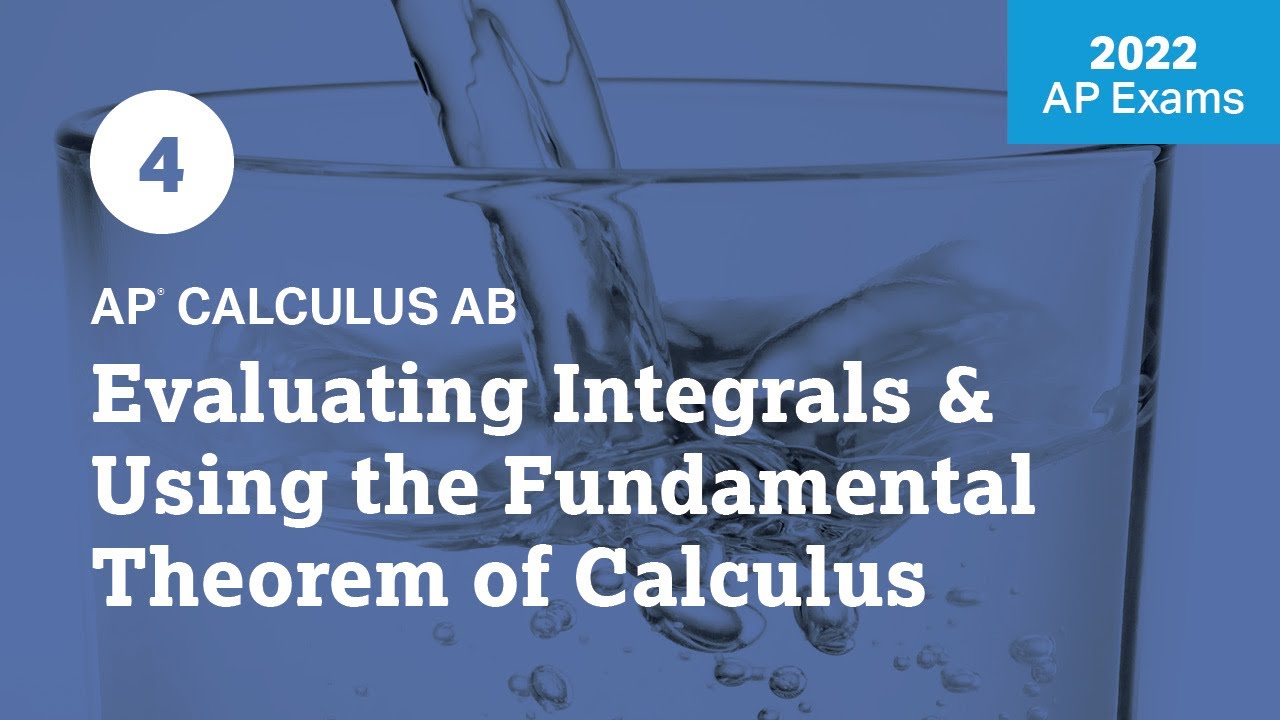5 | MCQ | Practice Sessions | AP Calculus AB
TLDRIn this instructional session, Virge Cornelius and Mark Kiraly guide viewers through a series of calculus problems, emphasizing the importance of understanding the problem and applying the right theorems. They begin with a question involving the fundamental theorem of calculus to find the value of a function at a given point, using the integral of its derivative. The instructors then tackle a problem on the continuity of a function, highlighting the conditions for continuity and how to apply the intermediate value theorem. They also discuss the mean value theorem and its requirements for differentiability. The session includes a practical application of calculus to find the temperature change in a gym over time. Throughout the video, the instructors stress the importance of using the calculator judiciously, taking time to read and understand the problem, and actively engaging with the material by writing and underlining key points. The session concludes with a reminder to apply known methods and stay dynamic with problem-solving during exams.
Takeaways
- 📚 **Understanding the Fundamental Theorem of Calculus**: The integral of the first derivative can be used to find the total change in a function, which can then be used to determine the function's value at a different point.
- 🔍 **Reversing the Order of Integration**: When the lower bound is higher than the upper bound in an integral, it's still valid to calculate the integral by reversing the limits.
- 🧮 **Calculator Usage in Calculus**: While calculators are allowed, they are not always necessary for every problem. It's important to know when to use them effectively.
- 📈 **Using Accumulation Functions**: The concept of accumulation functions is central to solving calculus problems, especially when dealing with derivatives and integrals.
- 🤔 **Thinking Through Multiple Approaches**: There are often various ways to approach a calculus problem, and it's beneficial to spend time understanding each method.
- 📊 **Continuous Functions and Intermediate Value Theorem**: For continuous functions, if a function takes on two values, it must take on all values in between at some point in the interval.
- 📐 **Graphing and Visual Aids**: Sketching a quick graph can help visualize the behavior of a function and understand its properties better.
- ✅ **Accuracy in Answering Questions**: Ensure that the answer provided matches the question asked, especially when the question uses words like 'must be true'.
- 🔗 **Applying The Mean Value Theorem**: The Mean Value Theorem can be applied when a function is differentiable over an interval, but it requires careful consideration of the function's behavior.
- 🕒 **Time Management in Exams**: In exams like AP Calculus, time is allocated per problem, so it's crucial to manage time effectively and not spend too much on a single question.
- 📝 **Note Taking and Marking**: Actively taking notes, underlining, and marking key points in the problem can help in understanding and solving the problem.
- 📉 **Understanding Rates of Change**: The rate of change, as represented by a derivative, can be integrated to find the total change over an interval, which is useful for problems involving change over time.
Q & A
What is the main topic of discussion in the session?
-The main topic of discussion is the application of the fundamental theorem of calculus to find the value of a function based on its derivative and given function values.
What is the first derivative of the function f mentioned in the transcript?
-The first derivative of the function f, denoted as f prime of x, is equal to 2 times the cosine of x squared.
What is the value of f(3) given in the transcript?
-The value of f(3) is given as 7 and 1/2.
What is the approach suggested by Mark Kiraly to find the value of f(2)?
-Mark Kiraly suggests using the accumulation model of the fundamental theorem of calculus, integrating the first derivative from 3 to 2, and then adding the result to the known value of f(3) to find f(2).
Why does Virge Cornelius mention the importance of setting the calculator to radian mode?
-Virge Cornelius emphasizes the importance of setting the calculator to radian mode to ensure that it aligns with the units used in calculus exams, which typically use radians for angles.
What does the term 'must be true' in the question about the continuous function h imply?
-The term 'must be true' implies that the statement is a definite fact that can be concluded from the given information about the continuous function h, and it is not just a possibility.
What is the significance of the intermediate value theorem in the discussion about the function h?
-The intermediate value theorem guarantees that if a function is continuous on a closed interval, and it takes on values f(a) and f(b), then it must also take on every value between f(a) and f(b) at least once within that interval.
What is the purpose of discussing limits and continuity in the context of the function h?
-Discussing limits and continuity is important because these concepts are fundamental to calculus and are often tested on AP exams. They help in understanding the behavior of the function at specific points and intervals.
How does Mark Kiraly interpret the expression 65 plus the integral from 6 to 18 of h of t dt?
-Mark Kiraly interprets the expression as the total temperature change from 6 AM to 6 PM in the gym, where 65 degrees is the initial temperature at 6 AM, and the integral represents the total change in temperature over the next 12 hours.
What is the advice given by the instructors for approaching problems on the AP exam?
-The advice given by the instructors includes taking time to read and understand the problem, using the calculator only when necessary for calculus problems, and keeping the pencil moving by writing down and organizing thoughts and calculations.
What is the final integral calculation that Mark Kiraly performs to find the value of the integral from 1 to 5 of 2 times f of x plus 3?
-Mark Kiraly calculates the integral by first finding the integral from 1 to 5 of f of x, which is 15, and then adding the constant 3 times the length of the interval from 1 to 5, which is 12, resulting in a final answer of 42.
Outlines
📚 Introduction to Calculus Problem Solving
In this segment, Virge Cornelius and Mark Kiraly, teachers from different high schools, introduce session 5 focusing on calculus. They discuss a problem involving finding the value of a function f at x=2, given its first derivative and a point on the curve (x=3). They use the concept of accumulation from the fundamental theorem of calculus to solve the problem, emphasizing the importance of understanding the integral of the first derivative. The instructors also highlight the need for careful reading and the correct application of mathematical theorems, such as the intermediate value theorem and the mean value theorem.
🔍 Analyzing Continuity and the Behavior of Functions
The second paragraph delves into the concept of continuity in functions. Using a table of values for a function h, the instructors guide viewers on how to deduce which statements must be true based on the given data points and the property of continuity. They also discuss the implications of the intermediate value theorem and the necessity for a function to have a defined value, a limit, and for the limit to equal the function value at a point to be considered continuous. The paragraph concludes with an application of the mean value theorem to determine a potential slope of the function within a given interval.
🧮 Applying Definite Integral Properties
In this part, the focus shifts to using properties of definite integrals to find the value of an integral from 1 to 5, given the values of integrals from 1 to 10 and from 5 to 10. The instructors demonstrate how to combine these intervals and use the additive property of integrals to solve for the desired integral. They also show how to integrate a constant times a function over an interval and evaluate it geometrically as a rectangle. The discussion emphasizes the importance of understanding integral properties and applying them correctly.
⏱️ Interpreting the Integral as a Measure of Change
The final paragraph discusses the interpretation of an integral as a measure of change over time. Given a temperature function h(t) representing the rate of temperature change in a gym, the instructors explain how to calculate the total change in temperature from 6 AM to 6 PM by integrating the rate function over the interval from 6 to 18 (representing 18 hours after midnight). They clarify that the integral represents the total change, which is then added to the initial temperature to find the final temperature at 6 PM. The paragraph concludes with a reminder to utilize the calculator only for calculus problems and to keep the pencil moving while solving problems, emphasizing active engagement with the material.
Mindmap
Keywords
💡First Derivative
💡Fundamental Theorem of Calculus
💡Continuous Function
💡Definite Integral
💡Intermediate Value Theorem
💡Mean Value Theorem
💡Limits
💡Radian Mode
💡Integration
💡Differentiable Function
💡Rate of Change
Highlights
The fundamental theorem of calculus is used to find the value of f(2) given f'(x) = 2cos^2(x) and f(3) = 7.5
The integral of the first derivative can be used to find the total amount of change in a function
Starting from a higher lower bound and integrating backwards can make some students uncomfortable, but it is mathematically valid
The accumulation model of the fundamental theorem can be used to find function values
The definite integral can be used as an alternative to the accumulation model to find function values
The intermediate value theorem guarantees the existence of a value between two other values in a continuous function
The concept of limits and continuity is tested on almost every AP exam
Three conditions must be met for a function to be continuous at a point: the function value exists, the limit exists, and they are equal
The mean value theorem can be used to find the slope of a function between two points, but requires differentiability
Properties of definite integrals can be used to find the integral over a different interval
Factoring out a constant from an integral can simplify the calculation
The integral of a rate function, such as temperature change, can be used to find the total change in the quantity over an interval
Adding the initial value to the total change gives the final value of the quantity after the interval
Just because a calculator is allowed doesn't mean it will be used for every problem - take time to read and understand what is being asked
Writing things down, underlining, circling, etc. can help with problem solving and understanding
If stuck, do what you know - write out an integral, draw a graph, etc. to help move forward
The session includes a variety of problems that test different theorems and concepts in calculus
Transcripts
Browse More Related Video

2022 Live Review 5 | AP Calculus AB | Focusing on the Big Theorems Including IVT, EVT, & MVT

2021 Live Review 5 | AP Calculus AB | Understanding the Big Theorems Including IVT, EVT, & MVT

2 | FRQ (Calculator Active) | Practice Sessions | AP Calculus AB

2022 Live Review 4 | AP Calculus AB | Integrals & Using the Fundamental Theorem of Calculus

3 | FRQ (No Calculator) | Practice Sessions | AP Calculus AB

Fall 2023 MNC: Trick or treat - Some important theorems in differential calculus
5.0 / 5 (0 votes)
Thanks for rating: